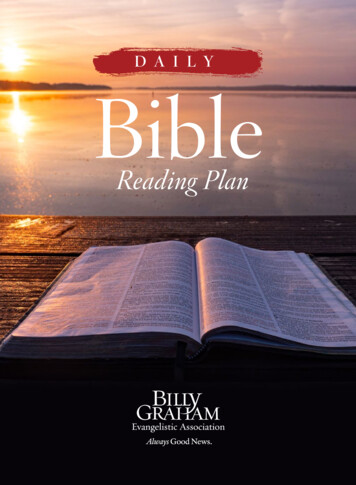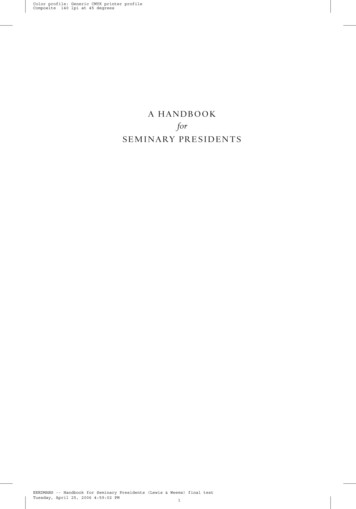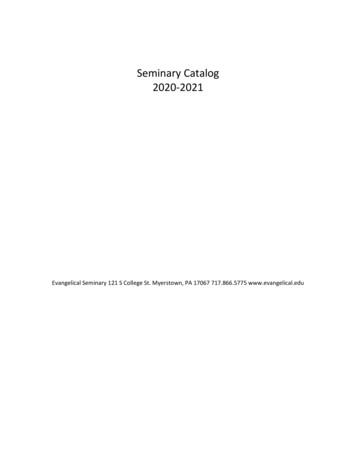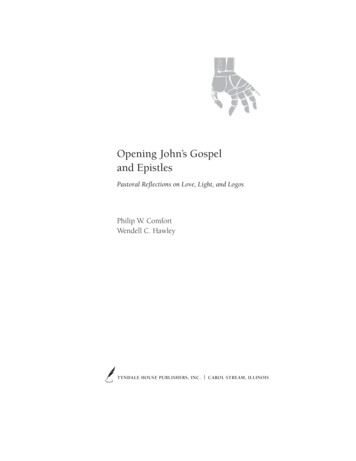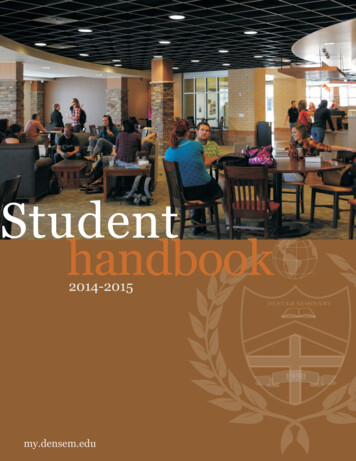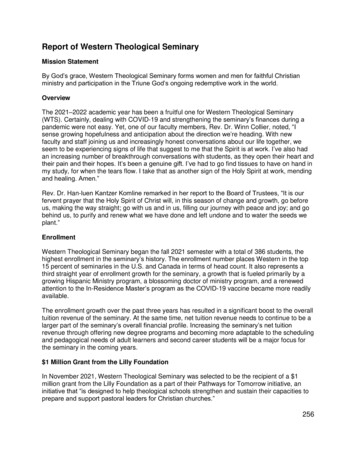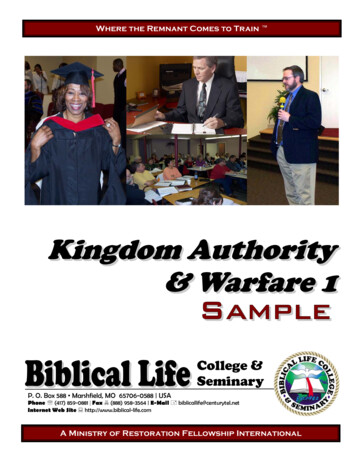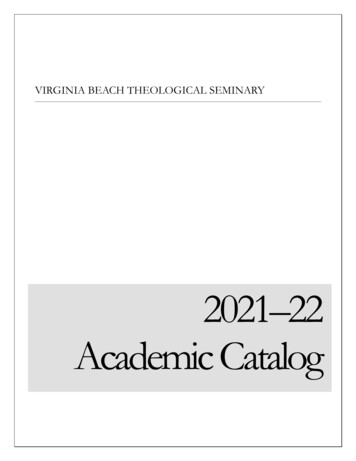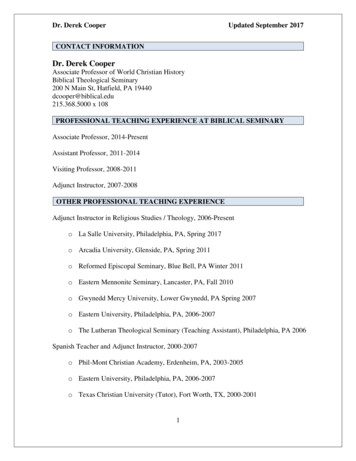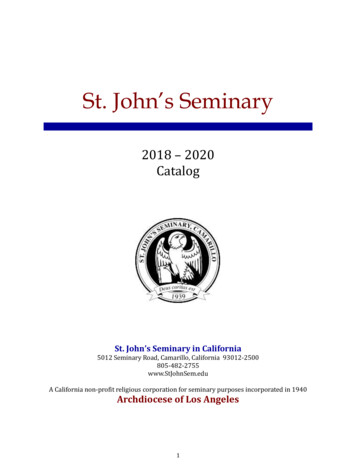
Transcription
St. John’s Seminary2018 – 2020CatalogSt. John’s Seminary in California5012 Seminary Road, Camarillo, California 93012-2500805-482-2755www.StJohnSem.eduA California non-profit religious corporation for seminary purposes incorporated in 1940Archdiocese of Los Angeles1
AccreditationSt. John’s Seminary in California is accredited by the Commission on Accrediting of theAssociation of Theological Schools in the United States and Canada. The following degreeprograms are approved:Master of DivinityMaster of ArtsMaster of Arts in Pastoral MinistryThe commission contact information is:Commission on AccreditingAssociation of Theological Schools in the United States and Canada10 Summit Park Drive, Pittsburgh, PA 15275Telephone: 412-788-6505 Fax: 412-788-6510 Website: www.ats.eduSt. John’s is also accredited by the Senior College and University Commission of the WesternAssociation of Schools and Colleges.The commission contact information is:Senior College and University CommissionWestern Association of Schools and Colleges985 Atlantic Avenue, Suite 100, Alameda, CA 94501Telephone: 510-748-9001 Fax: 510-748-9797 Website: www.wscuc.orgInstitutional MembershipsAmerican Association of Collegiate Registrars and Admissions OfficersAssociation for Theological Field EducationCatholic Association for Theological Field EducationNational Association for Lay MinistryNational Association of Catholic Theological SchoolsNational Catholic Educational AssociationPacific Association of Collegiate Registrars and Admissions OfficersSt. John’s Seminary is approved by the State of California, Department of Consumer Affairs,Bureau for Private Postsecondary and Vocational Education for the training of personsreceiving Veterans Administration benefits under the provisions of U.S. Code Sections3671(a) and 3672(a), Chapter 36, Title 38, United States Code.The school is authorized under federal law to enroll non-immigrant foreign students (F-1).Notice of Nondiscriminatory Policy as to StudentsSt. John’s Seminary does not discriminate on the basis of race, color, nationality, or ethnicityin the administration of its admission policies, educational policies, and scholarship andloan programs administered by the school.DisclaimerWhile every effort is made to ensure the accuracy of information in this catalog,St. John’s Seminary reserves the right to make changes at any time without prior notice.2
939404448545960626472979899105General InformationMission StatementBoard of DirectorsArchbishop’s MessageRector’s WelcomeMensaje del RectorHistory of St. John’s SeminaryDirectives for Religious CongregationsDirections to the SeminaryAcademic CalendarAdmissionsAdmission Requirements for the Master of ArtsAdmission Requirements for the Master of Arts in Pastoral MinistryFinancial InformationTuition and FeesFinancial AidEndowed ChairsEndowments and Special FundsCommunity LifeFormationHuman FormationSpiritual FormationPastoral FormationPastoral Field EducationIntellectual FormationAcademic ProgramsPre-Theology Certificate ProgramMaster of Divinity Degree ProgramMaster of Arts Degree ProgramMaster of Arts in Pastoral Ministry Degree ProgramLanguage and Cultural Studies ProgramsLibrary ServicesGrading SystemAcademic Policies and ProceduresCourse DescriptionsAdministration and FacultyCommittees and CouncilsFacultyIndex3
Mission StatementThe primary mission of St. John’s Seminary is to prepare candidates for service as RomanCatholic priests by assisting them to: grow as disciples of Jesus Christ;discern the vocation to which God calls them;root themselves in Word and Sacrament and the Church’s theological tradition;integrate the spiritual, human, intellectual, and pastoral dimensions of their lives;anddevelop skills for ministry, leadership, and evangelization in a culturally diverseChurch.Board of DirectorsMost Rev. José H. Gomez, S.T.D.ChairmanMr. Daniel K. Schwala PresidentMr. Chris Meissner Vice PresidentMr. Philip M. Hart TreasurerSr. Angela Hallahan, C.H.F. SecretaryRev. Marco A. Durazo RectorMr. Jose M. (Butch) Alandy Committee ChairMs. Jayne Quinn, Ed.D. Committee ChairRev. Msgr. Albert BahhuthMr. Mike BirkholmMs. Yolanda BrownRev. Randy CamposRev. Jorge GarciaSr. Regina Marie Gorman, O.C.D.Mr. Kevin McCardleRev. John MoneypennyMs. Elizabeth (Libbie) Patterson, Ph.D.Mr. Joe SandersMr. William ShawMrs. Cambria TortorelliRev. Samuel Ward4
Archbishop’s MessageI have a special devotion to St. RafaelGuízar Valencia. He was a courageousbishop in Mexico during the period in thelast century when the Catholic faith waspersecuted and outlawed. For more thanfifteen years, he ran a secret seminary thattrained more than 300 men for thepriesthood.St. Rafael said: “A bishop can do withoutthe miter, the crosier, and even without thecathedral. But he cannot do without theseminary, since the future of his diocesedepends on it.” I believe these words verymuch. They are an inspiration for myministry.St. John’s Seminary is the future of thisgreat Archdiocese. This seminary isforming my future priestly co-workers forthe apostolic work of serving the family ofGod and building the city of charity andtruth here in Los Angeles.The priesthood is a gift and a mystery inGod’s plan for the salvation of the world.Every priest receives a special calling fromGod. This calling is an invitation to a greatadventure of self-surrender and service toGod’s plan.Most Reverend José H. Gomez, S.T.D.Archbishop of Los AngelesThe priest has a special heart. It is the heart of a disciple and a missionary. It is a heart thatlongs to share the joy of Jesus Christ and his love with his brothers and sisters. What abeautiful privilege to minister in persona Christi, in the person of Christ! Through his priests,Jesus Christ speaks his words of forgiveness. Through his priests, he offers this world hisBody and Blood as the bread of life.I ask God’s blessings on this seminary and all its students, faculty, administrators, andbenefactors. May this always be a place where men find joy in friendship with Jesus Christand grow together in knowledge and holiness and love for him.I entrust these intentions to Our Lady of the Angels, patroness of this great Archdiocese. 5
Rector’s WelcomeWelcome to the home of St. John’s Seminary, an international institution in SouthernCalifornia devoted to preparing men who have responded generously to God’s call to thepriesthood. Founded in 1939, St. John’s has formed more than 1,300 priests for bothreligious and diocesan ministry.Following the instructions contained in the Apostolic Exhortation Pastores Dabo Vobis andin the Program for Priestly Formation, 5th edition, and informed by the Ratio FundamentalisInstitutionis Sacerdotalis, our seminary is characterized by its dedication to forming men viaa holistic integration of spiritual, human, academic, and pastoral dimensions, as described inour Mission Statement.Given the multicultural environment in which we live, the growing Hispanic presence in theUnited States, and the rapid transformation of our society brought about in large measureby the new social media, our seminary works to educate priests who are passionate for theGospel, creative ministers of God’s mercy, and prepared to face the challenges of the newmillennium.May this catalog provide you with some insight into daily life and formation at St. John’s.I ask that you remember the seminary and our important work in your prayers; if you areable, please prayerfully consider supporting our missionthrough a charitable donation as well.On behalf of our faculty, our staff, and our seminarians,thank you for your interest in St. John’s Seminary. May thefavor of the Lord our God be ours and prosper the work ofour hands.God bless you. Rev. Marco A. Durazo, S.T.D.Rector/President6
Mensaje del RectorBienvenidos a la casa del Seminario de San Juan, institución internacional en el sur deCalifornia dedicada a preparar hombres quienes han respondido generosamente al llamadosacerdotal. Fundado en 1939, el Seminario de San Juan ha formado más de 1,300 sacerdotestanto para el ministerio de la vida religiosa como diocesana.Siguiendo la instrucción contenida en la Exhortación Apostólica Pastores Dabo Vobis y en laquinta edición del Programa de Formación Presbiteral, y reflexionando en el contenido deRatio Fundamentalis Institutionis Sacerdotalis, nuestro seminario se caracteriza por ladedicación a la formación de hombres íntegros en las dimensiones espiritual, humana,académica y pastoral, tal como lo describe nuestra misión institucional.Debido al ambiente multicultural en que vivimos, el crecimiento de la presencia hispana enlos Estados Unidos, y la rápida transformación de nuestra sociedad influenciada en granparte por los medios de comunicación social, nuestro seminario trabaja para educarsacerdotes apasionados por el Evangelio, creativos administradores de la misericordia deDios, y capaces de enfrentar los retos del nuevo milenio.Que este catálogo les proporcione una idea sobre la vida y formación del seminario. Lespido que recuerden en sus oraciones esta institución y a quienes colaboran con tanimportante labor; y si es posible, favor de considerar con devoción y apoyar nuestra misióna través de su donación caritativa.A nombre de nuestra facultad, el personal administrativoy seminaristas, les doy las gracias por interesarse ennuestro seminario. Que la bondad del Señor, nuestro Diossea sobre nosotros y conduzca las obras de nuestrasmanos.Dios les bendiga. Rev. Marco A. Durazo, S.T.D.Rector/Presidente7
History of St. John’s SeminaryOn March 3, 1927, the Board of Diocesan Seminary Trustees accepted an offer from DonJuan Camarillo (1867-1936) of 100 acres high on an expansive terrace of the RanchosCalleguas and Las Posas in Ventura County. According to the intentions of the donor, the landwas to be used as a site for a seminary to be named in honor of St. John the Evangelist.Surrounded by orange and lemon groves, and featuring rare and beautiful landscaping, thesite provides a lovely panorama of the fertile coastal plains below, with long highwaysstretching between orchards and cultivated fields.On January 14, 1938, after announcing a successful, concerted campaign for funds, the MostReverend John J. Cantwell, D.D., Archbishop of Los Angeles, proposed the building of St.John’s Seminary. In August of that same year, ground was broken, and on March 19, 1939,the cornerstone was laid in the already erected building. Archbishop Cantwell entrusted theadministration of the seminary to the Vincentian Fathers. On September 12, 1939, under theleadership of its first rector, Reverend William P. Barr, C.M., and ten faculty members, St.John’s Seminary opened its doors to 70 candidates for the priesthood.The development of the grounds proceeded swiftly. The chapel was solemnly consecrated byArchbishop Cantwell on October 8, 1940, although artistic additions continued to be madein ensuing years. On October 14, 1940, the Apostolic Delegate dedicated the Edward L.Doheny Memorial Library. By May 1941, the episcopal residence had been completed, and inApril 1942, the seminary swimming pool was opened.After the death of Archbishop Cantwell on October 30, 1947, James Francis McIntyrebecame the second Archbishop of Los Angeles. Shortly thereafter, Reverend Francis Koeper,C.M., was named rector of the seminary and served from 1948 to 1954. During hisadministration, St. John’s received its first accreditation from the Western CollegeAssociation in 1951. Reverend James Richardson, C.M., succeeded Father Koeper as rector in1954.Between 1954 and 1958, Cardinal McIntyre brought to completion the long-plannedexpansion of the seminary. In 1956, the Cardinal dedicated a new dormitory-classroomrecreation building immediately behind the original complex. The addition increased thenumber of classrooms from five to seven and the number of student rooms from 104 to 180.Reverend William Kenneally, C.M., rector from 1958 until 1967, supervised the constructionof St. John’s Seminary College, which was completed in 1965 on the crest of the hill abovethe theologate. The new St. John’s Seminary College housed three dormitories, anadministration building, a refectory, an auditorium, the Carrie Estelle Doheny MemorialLibrary, and St. James Chapel. When the college opened, the existing program of six years atthe junior seminary and six years at the major seminary came to an end. The system wasregularized into the more common four year segments: high school, college, and graduateschool, with each institution situated at a separate location. St. John’s Seminary nowdevoted its entire program to graduate level theological education and was empowered togrant a Master of Arts degree.During the administration of Reverend John Danagher, C.M., from 1968 to 1973, St. John’sworked to respond to the Second Vatican Council’s new ideals for priestly formation. In lightof these ideals, deacons were introduced to pastoral ministry by working in parishes on8
weekends, while all other students participated in supervised learning experiences in thefield, including catechetics, social work, hospital ministry, adult education, vocationalpromotion, and youth retreats. Academic standards were improved by affiliation with theAmerican Association of Theological Schools. In 1970, the year of his 50th anniversary ofpriestly ordination, Cardinal McIntyre retired from the administration of the Archdiocese.He was succeeded by his coadjutor, Archbishop Timothy Manning, who had assistedArchbishop Cantwell as secretary and auxiliary and Cardinal McIntyre as vicar-general andchancellor. Pope Paul VI honored him in 1973 with promotion to the cardinalate. From 1973to 1978, under the leadership of Reverend John Grindel, C.M., the seminary renewed itsaccreditation with the Western Association of Schools and Colleges (WASC) and was givenits initial accreditation in 1976 from the Association of Theological Schools in the UnitedStates and Canada (ATS). In 1981, both agencies reaffirmed accreditation for ten years, themaximum term accorded.During the administration of Reverend Charles Miller, C.M., from 1978 to 1987, the seminarymodified its overall program in the interest of enriched spiritual, pastoral, and academictraining. In 1979, St. John’s developed its Pre-Candidacy Program for college graduates withno previous seminary experience. In 1982, two new elements were developed. The first wasa six-week Intensive Period of Spiritual Formation (IPSF) for first-year seminarians, and thesecond was a six-month parish internship in home dioceses prior to diaconate ordination.Continued evaluation of these programs has resulted in some modification in schedule andlocation.Reverend Monsignor George Niederauer, the first Archdiocesan priest and the first alumnusto be named rector of St. John’s Seminary, served from June 1987 through June 1992. Theseminary briefly experimented with a small six-week summer session beginning in July1989. St. John’s also experimented with a January interim, and at the same time it updatedthe pastoral Spanish program by integrating new language requirements into thecurriculum. From 1990 to 1992, Monsignor Niederauer led St. John’s through itsreaccreditation process.When Monsignor Gabino Zavala, J.C.L., began his term as rector on July 1, 1992, the seminaryhad just received a nine-year reaccreditation from its ATS and WASC accrediting agencies.Monsignor Zavala’s term as rector was interrupted when he was ordained as AuxiliaryBishop of Los Angeles on March 19, 1994.Reverend Monsignor Jeremiah J. McCarthy, Ph.D., who had been serving as Vice-Rector andAcademic Dean, was named Rector/President on May 31, 1994. Under MonsignorMcCarthy’s direction, St. John’s undertook a revision of its formation tasks andadministrative policies in a coordinated effort to position itself to continue into the twentyfirst century as an effective and high quality institution. Monsignor McCarthy strengthenedthe seminary’s formational focus by creating the position of Director of Formation andEvaluations. Under Monsignor McCarthy’s leadership, the seminary also embarked on“Project 21”, which strengthened the academic formation of the seminary with a number ofnew initiatives, including the integration of twenty-first century information technologyacross the entire campus.Reverend Monsignor Helmut A. Hefner, J.C.L., began his term as Rector/President of St.John’s Seminary on June 10, 2001. In 2002, under his direction, the seminary received arenewal of accreditation from ATS and WASC for the maximum term accorded. In 2003, St.John’s Seminary College was closed due to declining enrollment. The seminary assumedresponsibility for those remaining college seminarians and supplied the necessary academic9
and formational program for them to complete their course of study. The “teach out” wassuccessfully completed in May 2005. Since then, the college facility has been part of astrategic plan to be developed in order to enhance the seminary’s endowment.As part of the seminary’s ongoing effort to improve its overall program of formation, theJoint Board of Directors, under the direction of Monsignor Hefner, initiated a strategic planin 2001. Among the many initiatives that surfaced in the seminary’s process of ContinuousQuality Improvement (CQI) was the need to update the institution’s facilities. As a means ofproviding formation opportunities for lay ecclesial ministers, the seminary began the Masterof Arts in Pastoral Ministry (M.A.P.M.) degree program in 2003. The M.A.P.M. and the M.A.degrees are offered for qualified lay ministry students. Beginning in 2006, under theleadership of Cardinal Roger Mahony, the seminary began planning and fundraising for theremodel of the seminary residences. In 2008, the remodel of the first residence, Mary Dorm,was completed; a similar remodel of Thomas Dorm was completed in June 2009.On July 1, 2007, Reverend Monsignor Craig A. Cox, J.C.D., D. Min., was appointed by CardinalMahony as the seminary’s twelfth Rector/President. During his administration, MonsignorCox oversaw the completion of the remodeling of two dormitories, with the vision ofremodeling Joseph Dorm in the near future. Other improvements included provisions forhandicap access to seminary buildings and upgrades to seminary infrastructure in facilitiesand grounds. The Office of Institutional Advancement was established in 2007 to enhancethe seminary’s community relations, fundraising, and alumni programs. The DistinguishedAlumni Awards Dinner was begun in 2008 to acknowledge the significant contributions ofour alumni, both clergy and lay, to the life of the Church.On March 1, 2011, Archbishop Jose H. Gomez, S.T.D., assumed leadership of the Archdioceseof Los Angeles. He has made the program of priestly formation at St. John’s Seminary a toppriority of his ministry along with recruitment of vocations for priestly ministry.On July 1, 2014, Archbishop Gomez appointed Reverend Monsignor Marc V. Trudeau, D. Min.,as Rector/President. In January 2015, the remodel of Joseph Dorm was completed andstudents were able to move in. This was the last of the three dorms to be outfitted withen-suite bathrooms for each student room. As part of a strategic plan, a new academic deanwas hired; he also serves as academic advisor for students in the college formation programat Queen of Angels Center for Priestly Formation. A director of development, responsible forfundraising at both institutions, was also hired. Greater collaboration between St. John’sSeminary and Queen of Angels Center will prove to strengthen both programs. During the2014-2015 academic year, celebration of the 75th anniversary of its founding gave theseminary incentive to address and fill a number of other needs: a technology upgrade inclassrooms, the reestablishment of a Capital Improvements Committee responsible forbuildings and grounds, and the creation of a new interactive website and new social mediaplatforms.On June 7, 2018, Monsignor Trudeau was ordained auxiliary bishop of the Archdiocese ofLos Angeles, and on July 1, 2018, Reverend Marco A. Durazo, S.T.D., was appointed byArchbishop Gomez to serve as the 14th rector of St. John’s. At the time of his appointment,St. John’s had just received reaccreditation by WASC for an eight-year term. 10
Directives for Religious CongregationsSt. John’s Seminary recognizes the many values that are evident when seminarians studyingfor the diocesan priesthood are able to be formed in a seminary community enriched byseminarians who belong to religious orders and congregations. The Program of PriestlyFormation, 5th edition, states that: “The primary context of religious priesthood ordinarilycomes from the nature of religious life itself. Religious who are called to priesthood exercisethat ministry within the context of their religious charism. The exercise of priesthood takeson a distinctive quality for a religious, depending upon the rule of life and the charism of aparticular institute or society” (PPF, #28).In light of these values, St. John’s Seminary sees the opportunity to collaborate in thepriestly formation of members of religious orders and congregations as an important part ofits mission. Indeed, the seminary sees itself as an attractive environment for the theologicaltraining of seminarians of religious orders and congregations. As such, St. John’s is open toboth resident and non-resident seminarians from religious orders or congregations – that isto say, those who reside at the seminary, and those who live in their religious communities.General Principles1. St. John’s Seminary recognizes, as does the Program of Priestly Formation, thatreligious congregations have individual formation programs which they have a dutyand a right to carry out and which involve three aspects:a. personal and spiritual growth;b. pastoral formation; andc. academic formation.In general, St. John’s presumes that, in most circumstances, formational elements (a)and (b) above are integral elements of the formation programs of individual ordersand congregations that have created their own external houses of formation. Assuch, St. John’s normally assumes responsibility only for the academic formation (c)of those seminarians unless a religious community asks the seminary to enter into amore collaborative role with them in the other areas of formation mentioned in thePPF. Also, St. John’s would recognize and welcome a collaborative, rather than aunilateral, responsibility for elements (a) and (b) for seminarians from religiousorders or congregations who reside at the seminary.2. The seminary and religious orders or congregations will work together to ensurethat non-resident students not be required to spend unreasonable amounts of timeat the seminary.3. The seminary will maintain, as much as possible, for the sake of good order andfairness, some measure of consistency in what is required of diocesan and religiousseminarians who participate in the same programs, whether academic orformational.4. To the best of its ability, the seminary administration will communicate to the localdirectors of students of the religious congregations any changes made in theactivities and schedules of the seminary community that affect their students.11
AdmissionsReligious students who are sent to St. John’s Seminary are evaluated for admission on thebasis of their level of participation in seminary programs.1. If they are to be involved solely in the academic program, then they are evaluatedonly on their academic records.2. Those who are to be admitted as resident students are evaluated on the basis of afull range of personal, spiritual, vocational, and psychological considerations, as wellas their academic record.Normally, St. John’s expects all religious candidates requesting admission (post pretheology) to have completed their novitiate.FinancesThe cost of attending St. John’s Seminary includes tuition and fees, room and board, andpossibly some formational program expenses. Tuition is approximately 60 percent of thetotal yearly cost, while room and board is roughly 40 percent.1. Resident students pay for tuition and room and board.a. If a religious student receives an administrative referral for mandatorypsychological testing and/or counseling, or if he desires it on his own, the cost,including transportation to and from the center, is the responsibility of thereligious order or congregation. It is important to note that administrativereferrals are not optional according to seminary policy.b. Except for required Field Education assignments, the seminary does not providepersonal transportation for seminarians.2. Non-resident students may be required to pay for tuition and for any other expensesthey may accrue on an ad hoc basis, including refectory meals, retreats, days ofrecollection, and other formational events outside the academic arena that they maywish to participate in.Spiritual Formation1. Resident students are expected to participate fully in the seminary’s spiritualformation program unless other arrangements have been mutually agreed upon bytheir congregations and the seminary.2. Non-resident students are not expected to be involved in any aspects of this programunless by a mutual agreement between the seminary and their religious director offormation. Nevertheless they are very welcome to attend any and all spiritualexercises, including daily Liturgy of the Hours and Eucharistic celebrations. Externalformation directors are welcomed and encouraged to make themselves available forthe regular schedule of presiders at the community’s daily Eucharistic celebrations.Pastoral FormationField Education is an integral part of the seminary’s academic program and is required forthe Master of Divinity degree. While the seminary is willing to dialogue with religious ordersand congregations that propose specific programs, the seminary, in order to maintain itsacademic integrity, reserves the right to make the final evaluation of the suitability of anysite of pastoral formation that involves the Field Education program and, as such, theacademic degree program.Academic FormationWhile the seminary recognizes a primary need to maintain the integrity of its academicprogram in light of its accountability to accrediting agencies, the following may beconsidered:12
1. That, whenever possible, the distribution of daily classes will be made with aconsideration for non-resident students so as to allow them to spend as much timeas possible in their local community.2. That the seminary will attempt to collaborate with religious orders andcongregations that have students at St. John’s in planning accredited electives ofspecific interest to religious seminarians.EvaluationsNon-resident seminarians normally receive only grade reports from St. John’s. Residentseminarians undergo and receive the complete formational evaluation as outlined in theseminary’s Student Handbook.Ministries and OrdinationWhile St. John’s Seminary recognizes that it is the responsibility of religious superiors to calltheir students to orders and ministries, and that likewise it is the prerogative of thosesuperiors to establish the date and place for the ceremonies to take place, the seminaryrequests, for the good order of the seminary and to help maintain the integrity of itsacademic program, that ordinations be celebrated either after the conclusion of theseminary’s academic year or at least during an official seminary vacation period. Normally,seminarians of religious orders or congregations who have been called to receive either oneof the ministries or the diaconate would be very welcome to participate in the seminary’sown annual ceremonies. The seminary would like to be advised by the order or communityof any extraordinary ordination dates as soon as they are arranged.Annual Review of These DirectivesIt is the intention of St. John’s Seminary to undertake annually a review of these directives incollaboration with all religious orders and congregations that have seminarians at St. John’s. Dioceses and Religious CommunitiesIn fall 2018, the following dioceses and religious communities were represented by St.John’s seminarians:Archdiocese of Los Angeles, CaliforniaDiocese of Fresno, CaliforniaDiocese of Monterey, CaliforniaDiocese of Orange, CaliforniaDiocese of San Bernardino, CaliforniaDiocese of San Diego, CaliforniaMaronite Eparchy of Our Lady of Lebanonof Los AngelesDiocese of Tucson, ArizonaFriars of the Sick Poor (F.S.P.)Congregation of Jesus and Mary (C.J.M.)13
Directions to St. John’s SeminarySt. John’s Seminary in California5012 Seminary Road, Camarillo, California 93012-2500805-482-2755www.StJohnSem.eduSt. John’s Seminary is located in Ventura County, in the city of Camarillo, approximately55 miles northwest of Los Angeles.From Los AngelesTake the Ventura Freeway (Highway 101) west and north to Camarillo. Exit at the FlynnRoad off ramp and move to the center lane. At the traffic light, proceed straight on FlynnRoad. Follow Flynn Road until it ends at the traffic light at Upland Road. Turn right onUpland Road, cross the bridge, and turn left at the entrance to the seminary. Turn left againand follow the instructions posted at the kiosk to gain entrance to the campus.From Santa BarbaraTake the Ventura Freeway (Highway 101) south to Camarillo. Exit at the Lewis Road offramp and turn left at the off ramp traffic light (Ventura Boulevard). Turn left again on LewisRoad (Highway 34) and follow it to the third traffic light at Las Posas Road and Upland Road.Turn right on Upland Road, cross the bridge, and turn left at the entrance to the seminary.Turn left again and follow the instructions posted at the kiosk to gain entrance to thecampus.From the San Fernando ValleyTake the Ronald Reagan Freeway (Highway 118) west to Moorpark. Exit at the Los AngelesAvenue (West) off ramp. Contin
St. John's Seminary 2018 - 2020 Catalog St. John's Seminary in California 5012 Seminary Road, Camarillo, California 93012-2500 . By May 1941, the episcopal residence had been completed, and in April 1942, the seminary swimming pool was opened. After the death of Archbishop Cantwell on October 30, 1947, James Francis McIntyre
